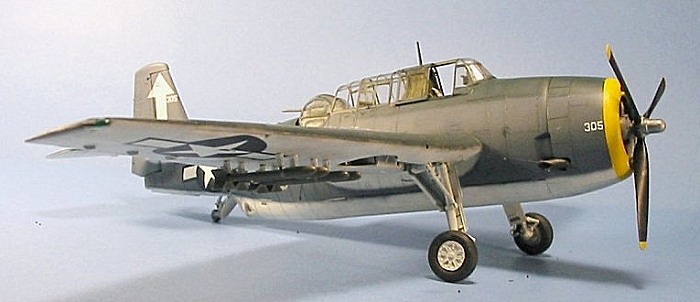
| KIT: | Accurate Miniatures 1/48 TBM-3 Avenger |
| KIT #: | ? |
| PRICE: | $29.95 or so when new |
| DECALS: | One option |
| REVIEWER: | Tom Cleaver |
| NOTES: | Belcher Bits conversion used |

| HISTORY |
Grumman’s TBF Avenger is the most successful naval strike aircraft ever built. The airplane was equally at home on fleet aircraft carriers, small escort carriers, and forward air bases, providing outstanding performance in torpedo strike, bombing, anti-submarine, and close air support roles. Easy to fly for a wartime-trained pilot, it was reliable and rugged and trusted by those who flew in it.
The Douglas TBD Devastator was the most modern carrier-based airplane in the world when it appeared in 1937. Such was the pace of aviation development that, a mere two years later it was seen as being in need of a more capable replacement. Purchased with peacetime funds, the 130 TBDs were completely inadequate for the needs of a world-wide naval war. Indeed, by June 6, 1942, there were only some 30 TBDs left in flyable condition and the airplane had thoroughly demonstrated its inability to survive in a modern air combat environment.
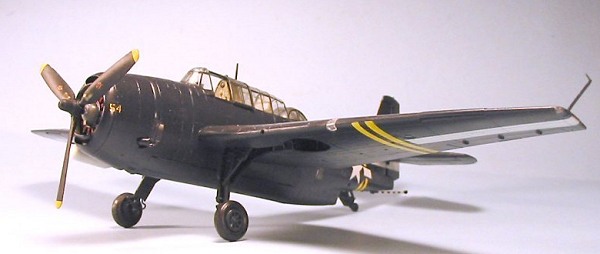 Fortunately, the Navy’s Bureau of Aeronautics had issued a requirement for
a new torpedo/level bomber in 1939. This was answered by Chance Vought
with an airplane designated the TBU-1, and by Grumman with the TBF-1. Both
aircraft were roughly similar, though the Grumman design was smaller - an
important point for a carrier-based airplane where deck space is at a
premium - and faster. The Vought aircraft was delayed by that company’s
commitment to designing and developing the F4U Corsair, and would later by
produced in limited numbers by Consolidated as the TBY-1 “Seawolf;” it
would not see combat.
Fortunately, the Navy’s Bureau of Aeronautics had issued a requirement for
a new torpedo/level bomber in 1939. This was answered by Chance Vought
with an airplane designated the TBU-1, and by Grumman with the TBF-1. Both
aircraft were roughly similar, though the Grumman design was smaller - an
important point for a carrier-based airplane where deck space is at a
premium - and faster. The Vought aircraft was delayed by that company’s
commitment to designing and developing the F4U Corsair, and would later by
produced in limited numbers by Consolidated as the TBY-1 “Seawolf;” it
would not see combat.
Grumman’s design included a power-operated rear turret of incredibly-simple design, and an internal bomb bay capable of carrying 2,000 lbs of ordnance, including general purpose or armor-piercing bombs, or a Mk. XIII torpedo. Operated by a crew of three, it had power-operated folding wings that could reduce its 54-foot span to 18 feet, thus allowing it to be operated from all Navy aircraft carriers. The original specification had called for a top speed of 320 m.p.h., which was revealed as only 274 mph when the first prototype flew in August 1941. Test flights revealed only a need for an extended fin for directional stability, everything else in the design performing as expected.
The first prototype was lost accidentally on November 29, 1941, when pilot Hobart Clark and engineer Gordon Israel mistook a fine mist of hydraulic fluid from a broken line for smoke that indicated an onboard fire, and bailed out ten miles from Grumman’s field at Bethpage. Fortunately, a second prototype had already been ordered, and was delivered on December 15, 1941, by which time the airplane had gone from Very Important to Absolutely Crucial in the Navy’s planning. In January 1942, the torpedo bomber was given the name “Avenger” - for obvious emotional reasons - a name it would more than live up to over the next three years.
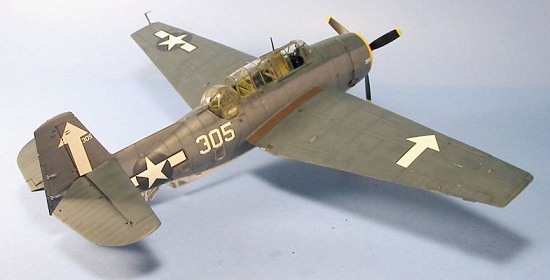 Production started quickly and the first squadron - VT-8, aboard the
“Hornet” - began receiving aircraft in April. Unfortunately, there was not
enough time for the squadron to fully convert to the new airplane before
the ship was ordered to the Pacific, where Torpedo Eight would fly into
immortality in their lumbering TBDs on June 4, 1942 at Midway.
Production started quickly and the first squadron - VT-8, aboard the
“Hornet” - began receiving aircraft in April. Unfortunately, there was not
enough time for the squadron to fully convert to the new airplane before
the ship was ordered to the Pacific, where Torpedo Eight would fly into
immortality in their lumbering TBDs on June 4, 1942 at Midway.
By the Battle of Midway, Grumman was producing 60 TBF-1s a month, and production exceeded 100 aircraft per month in November. By the end of 1942, Grumman had delivered 646 Avengers, and would attain a production rate of 150 per month through 1943. This wasn’t enough, and with the company’s prime commitment being the development and full-scale production of the even-more-desperately-needed F6F Hellcat, it was decided to bring in a second company to produce the Avenger. The General Motors in New Jersey was turned over to a new subsidiary known as Eastern Aircraft for this purpose. Those in the aviation industry were doubtful of the automotive industry’s ability to engage in mass production to the far-more-demanding tolerances of aircraft, but GM proved that - with the assistance of Grumman in simplifying assembly of the Avenger - they were capable of meeting the challenge. Production began in November 1942 with the assembly of Grumman-built TBFs, and by May 1943 had hit 100 aircraft - known as the TBM Avenger - a month. Of the 9,837 Avengers built during the war, Eastern Aircraft would produce 7,546 of them, including all of the more advanced TBM-3 version.
The Avenger went on to become the backbone of the Navy’s anti-U-boat campaign in the Atlantic, and - finally equipped in 1944 with the “ring-tail” Mk. XIII that allowed high-speed, higher-altitude torpedo strikes with weapon accuracy -Avengers sank the two biggest battleships ever built: the Musashi in October 1944 and her sister Yamato in May 1945.
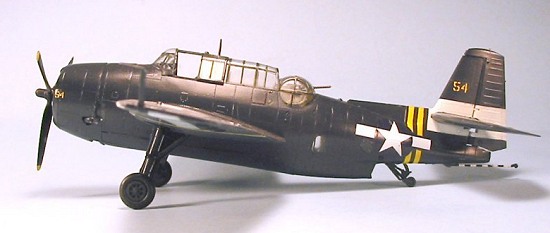 The TBM-3Avenger, which first flew in prototype form in May 1944, was an
attempt to deal with the problem that the Avenger was slightly
underpowered. An uprated R-2600 was used, with additional cooling vents to
allow maximum power on takeoff. Aft of the firewall, the changes were kept
to a minimum, with the most noticeable change being a different instrument
panel in the pilot’s cockpit. With minimal changes, production was easily
able to replace the TBM-1C on the production line, and the type first
appeared in the fleet in early 1945 in the air groups that replaced those
which had fought the Central Pacific campaign. The TBM-3 first went to war
with the Tokyo strikes in February 1944, and had completely replaced the
TBF-1C and TBM-1C in all Navy and Marine squadrons by the time of the
Okinawa campaign.
The TBM-3Avenger, which first flew in prototype form in May 1944, was an
attempt to deal with the problem that the Avenger was slightly
underpowered. An uprated R-2600 was used, with additional cooling vents to
allow maximum power on takeoff. Aft of the firewall, the changes were kept
to a minimum, with the most noticeable change being a different instrument
panel in the pilot’s cockpit. With minimal changes, production was easily
able to replace the TBM-1C on the production line, and the type first
appeared in the fleet in early 1945 in the air groups that replaced those
which had fought the Central Pacific campaign. The TBM-3 first went to war
with the Tokyo strikes in February 1944, and had completely replaced the
TBF-1C and TBM-1C in all Navy and Marine squadrons by the time of the
Okinawa campaign.
Marine torpedo bomber squadrons, primarily equipped with the TBM-3E version which did away with the lower windows and tunnel gun position in the radioman’s compartment - went aboard CVEs where they operated in support of Marine ground troops on Okinawa with great success.
The TBM-3 in its various subtypes continued in U.S. Navy service until the late 1950s, as well as equipping Royal Navy, Royal Canadian Navy, French Aeronavale and Japanese Air Self Defense Force units in the anti-submarine role throughout the 1950s.
| THE KIT |
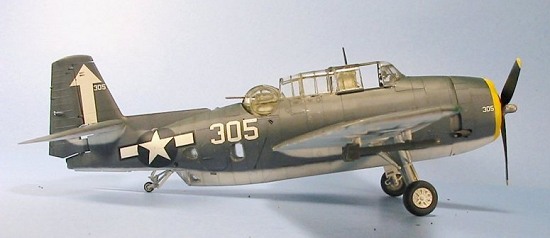 The Accurate Miniatures Avenger series first appeared in the fall of 1995 -
it’s hard to believe they have been around now for nearly ten years.
Following the collapse of the company four years ago, they became something
of a kit collector’s item, but the new Accurate Miniatures re-released the
kit last year, with the parts for all versions in the one boxing.
The Accurate Miniatures Avenger series first appeared in the fall of 1995 -
it’s hard to believe they have been around now for nearly ten years.
Following the collapse of the company four years ago, they became something
of a kit collector’s item, but the new Accurate Miniatures re-released the
kit last year, with the parts for all versions in the one boxing.
The Avengers were so accurate and well-detailed that the only aftermarket set for the kit I am aware of is the Belcher Bits conversion set to modify the TBM-3 to the Canadian Avenger ASW.3 version, which can also be used to create the TBM-3E (as I did here). There have been a number of decal sheets released over the years, but there have been no new ones and the others have been allowed to go out of production since 2001 when the kit was withdrawn from production. These decals can still be found.
The nice thing about the kit is it is relatively easy to build, and a beginning modeler can make a good-looking model. The big problem is masking off the considerable bit of canopy and turret clear areas, but this is more time-consuming than it is difficult.
| CONSTRUCTION |
Construction of the kit is very straightforward. I glued the wings and horizontal stabilizers together first, then turned to the fuselages.
 In
both cases, I began by painting the interior parts all Interior Green,
since GM-built Avengers dispensed with the use of Bronze Green in the
pilot’s cockpit. Once that was done I did the detail painting of the
various bits, and then proceeded with assembly. I did not glue the right
side of the fuselage to the rear cockpit bulkhead, so I could bend it out
sufficiently to inset the turret after painting was finished.
In
both cases, I began by painting the interior parts all Interior Green,
since GM-built Avengers dispensed with the use of Bronze Green in the
pilot’s cockpit. Once that was done I did the detail painting of the
various bits, and then proceeded with assembly. I did not glue the right
side of the fuselage to the rear cockpit bulkhead, so I could bend it out
sufficiently to inset the turret after painting was finished.
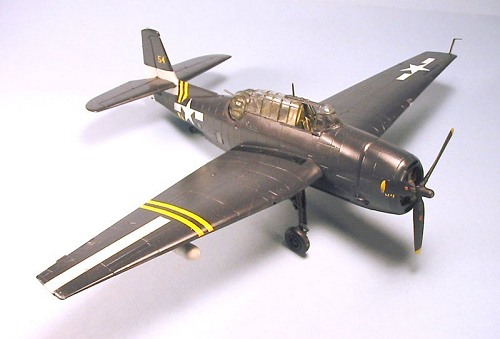 The TBM-3 Avenger was done with the bomb bay doors closed, which is
actually more difficult than doing the kit with the doors open, since I had
to reinforce the joints where the doors would be glued to the fuselage with
evergreen strip to provide a sufficient joining surface.
The TBM-3 Avenger was done with the bomb bay doors closed, which is
actually more difficult than doing the kit with the doors open, since I had
to reinforce the joints where the doors would be glued to the fuselage with
evergreen strip to provide a sufficient joining surface.
The TBM-3E Avenger assembly involved replacing the lower glass part with a resin part from the Belcher Bits conversion set, and in changing the attachment of the tail hook from the internal set-up provided in the kit to the external attachment used on this version. I also used the Belcher Bits resin radome on the wing.
In both cases, once the wings and tail were attached, I attached the landing gear, since it would be painted in the underside color.
Prior to painting, the canopies were masked off, which was a time-consuming process of applying Scotch tape and then trimming it to fit the window with my X-acto using a Number 11 blade. The windscreens were glued in position prior to painting the models.
| COLORS & MARKINGS |
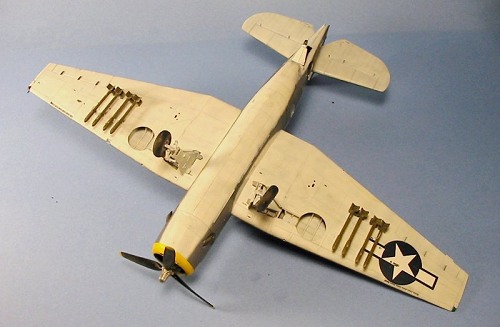 Painting:
Painting:
The TBM-3E was first painted with the U.S.S. Gloucester Bay yellow and white markings, which were airbrushed and then masked off, then the entire model was painted with Gunze-Sangyo “Midnight Blue.”
The TBM-3 was painted with the yellow nose used for identification during the February 1945 Tokyo Stripes, then painted with Gunze-Sangyo “Flat White,” “Intermediate Blue” and “Navy Blue” with some areas lightened to simulate sun and saltwater fading of the paint for the tri-color scheme.
Each model was given a coat of Future after the paint was dry.
Decals:
The VMTB-232 TBM-3E was marked with national insignia and yellow aircraft numbers from decal sheets found in the dungeon. The TBM-3 was marked with the kit decals for VT-84.
| FINAL CONSTRUCTION |
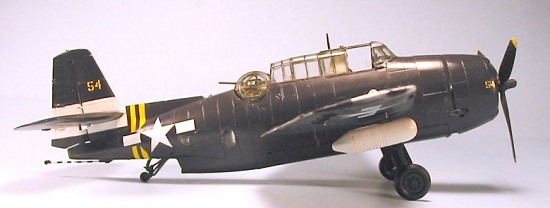 The canopies and turrets were unmasked. The gun slot in the turrets was
filled with white glue that was then painted Olive Drab to simulate the
fabric covers used. The turrets were then installed, then the rear
canopies and the antennas, with the sliding portions of the pilot’s canopy
attached last. Light exhaust stains were the only weathering applied, since
both these aircraft were well cared-for on their respective carriers.
The canopies and turrets were unmasked. The gun slot in the turrets was
filled with white glue that was then painted Olive Drab to simulate the
fabric covers used. The turrets were then installed, then the rear
canopies and the antennas, with the sliding portions of the pilot’s canopy
attached last. Light exhaust stains were the only weathering applied, since
both these aircraft were well cared-for on their respective carriers.
I substituted Hellcat props from the spares box for each model, since the kit only supplies the early prop used on the TBM-1C version.
| CONCLUSIONS |
Ten years after its initial release, the Accurate Miniatures Avenger series are still the most accurate Avengers available in any scale. A newbie modeler could easily use this as their first “detailed” model, with the assurance of obtaining a good-looking model.
May 2005
Kits courtesy of my wallet.
If you would like your product reviewed fairly and quickly by a site that has around 300,000 visitors a month, please contact me or see other details in the Note to Contributors.